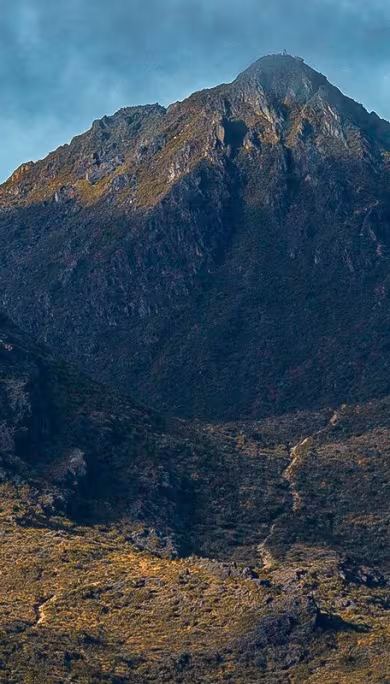Paramo: At the Top of the Hill
Paramo is the ecosystem that exists at Costa Rica’s highest altitudes, starting at around 9,800 feet above sea level. Paramos are typically dominated by grasslands and shrubs, occupying the space where trees stop growing and where snow begins falling. In Central America, paramos occur in Costa Rica and Panamá. They are called “isthmian paramos” to distinguish them from the Andean paramos further south. Costa Rica doesn’t have very tall mountains, so when you go to its highest peak you won’t find snow there. But you’ll find the paramo. In Costa Rica, the paramo is located in the highest part of the country’s largest mountain range: Talamanca.
This ecosystem offers a very different kind of landscape to most of the country. It may look barren in comparison to the lush rainforests, but it thrives on its own. It has a very delicate balance between wildlife, vegetation, and weather. It is true that paramos are similar to the arctic tundra biome, but have a key difference. In the tundra, large temperature shifts occur annually due to the seasons, while paramos have large temperature shifts across the day.
Some of the defining characteristics of Costa Rica’s paramo have existed for a long time. The rocky vistas were shaped millions of years ago by repeated glaciation during the Pleistocene (though it’s more recent than most think!). The shifting ice capes eroded the soil and gave it the particular shapes it has now, as well as its scattered lakes and peat bogs.
The shrubs and grasses are sometimes accompanied by very short and stout trees, but no vegetation grows too tall in the paramo. It covers the slopes of the mountains in mosaics dotted across the landscape. This isn’t an arid ecosystem, simply one with different expressions of life.
Why Are Paramos Important?

The importance of paramos is related to biodiversity and water resources. This ecosystem is where many of Costa Rica’s rivers and springs begin! A healthy, clean, and protected paramo will guarantee healthier and cleaner water for many animals and people. Also, paramos are very isolated ecosystems, like cloud forests, with flora and fauna species adapted to their specific conditions. If paramos suffer irreparable damage through human intervention, many of these species will disappear.
Another important aspect of paramos in Costa Rica is cultural. The Bribrí and Cabécar indigenous peoples have long lived in the Talamanca mountain range, and they consider it a solemn place of religious importance. In their cosmologies, this is where the gods lived. One of the reasons why there were no human populations in this area had to do with the respect they held for these places.
Keeping Paramos Safe from Human Intervention in Costa Rica

Historically, humans have not often inhabited paramos. Grazing is uncommon, as is agriculture. This has allowed this ecosystem to remain relatively unchanged by direct human activity even in recent years. Wildfires are one of the paramos’ most common threats. Paramos experience long dry seasons with strong winds. If a fire breaks out, it is difficult to put it out before it spreads rapidly. In recent decades, paramos have seen significant fire events generated by careless people, particularly visitors camping in the mountains.
Human-provoked climate change is the biggest threat to paramos. Due to global warming, flora and fauna have started moving their habitats to the highest areas of the mountains. This reduces the space where they live, and species compete more for resources and suffer from it. An often-ignored consequence of climate change is that it affects pollination. Plants and insects have internal clocks marked by the seasons. Temperature imbalances make it harder for plants and their pollinators to align their usual cycles, reducing the number of flora. This affects the food availability for the wildlife that depends on it. Fewer pollinators means fewer plants again, and the cycle continues.
As tourist destinations, paramos are a little off the beaten path and are less frequented than other ecosystems, but they still see thousands of visitors a year. Being respectful of the environment and minimally invasive is crucial to helping this ecosystem as much as possible. In Costa Rica, tearing off moss and lichen from the paramo’s rocks and plants is penalized by law. This is the expected level of respect when exploring the paramo.
Hiking in Costa Rica’s Paramo: A Landscape of Opportunities

Today, all Costa Rican paramos are legally protected within three national parks: Chirripó National Park, La Amistad International Park (shared with Panamá), and the Tapantí-Macizo de la Muerte National Park. The first two are the largest. These three parks have been jointly declared a Man and Biosphere Reserve by UNESCO. Other parts of the country can have some paramo vegetation, but on a much smaller scale, like the Irazú Volcano National Park.
Hiking is the most popular activity in paramos, especially for those seeking to reach Costa Rica’s highest point, Chirripó Peak. It’s one of the country’s hardest ascents, and a test for any avid hiker. Visitors will enjoy colorful fungi, moss, ferns, algae, dwarf bamboos, and small wildflowers. Wildlife is also more abundant than many think, but it tends to be of small size as well. Frogs, toads, salamanders, lizards, shrews, rabbits, ocelots, and the rarer pumas and tapirs are inhabitants of paramos.
There are at least 70 known species of birds living in the paramo, and some of them are quite special. The volcano hummingbird(Selasphorus flammula) is an endemic species of Costa Rica’s paramo. It’s also not even 3 inches in length! These are the sort of species that need the most protection and birdwatchers will find worthwhile. Paramos showcase a very unique aspect of Costa Rica which not many see. If you have a chance, stop to admire this ecosystem.





